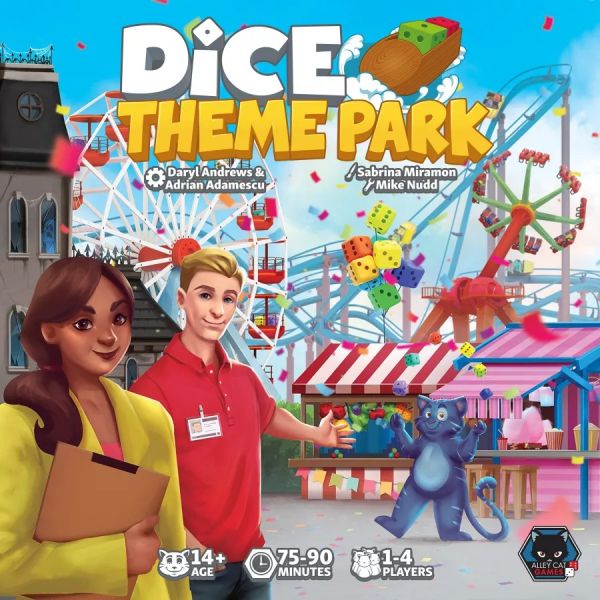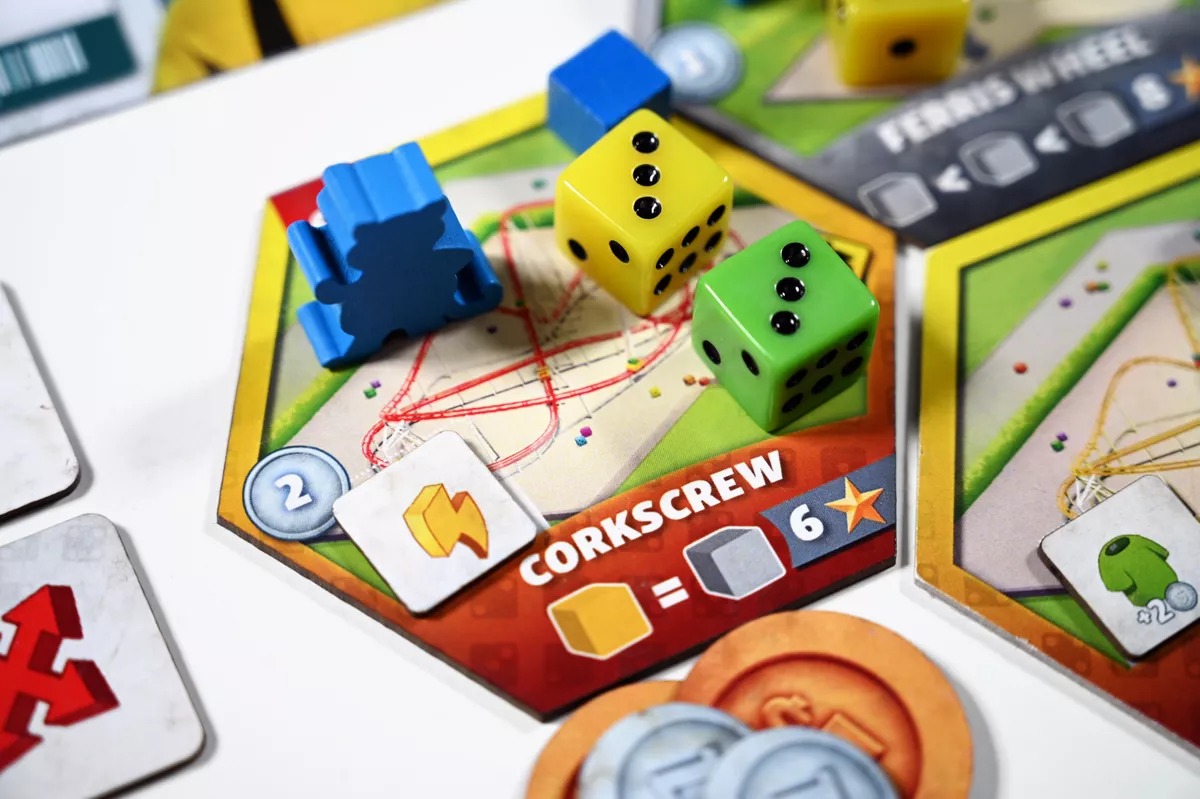Experience the Ups and Downs of Dice Theme Park

Dice Theme Park is a rollercoaster of luck and strategy that will have you competing to create the most exciting and profitable theme park possible.
Gameplay
As the game’s title suggests, dice are a big component of the game. Upon setting up the main board (which is double-sided for a four-round “quick” game or the usual five-round experience), add monorail cards which will end up housing the dice used to simulate park attendees. Monorail cards come in sets prepared for the number of players per game, and players will fill the dice bag with a set number, also dependent on player count. Draw out the number of dice equal to the open spaces for dice on the monorail cards, filling them left to right showing the number seen as drawn for each die. Draw a number of park tiles equal to the player count, plus one additional tile, to form a market.
Place out the objective card and place them in the appropriate round spots (spots 3 and 4 for a quick game, or spots 3 through 5 for a normal game). Each player will grab their own starting theme board, upgrade tokens (3 of each kind), all the cubes and a mascot meeple of their chosen color, and six staff cards also of their chosen color. Players may also elect to play with skill and administration cards, but it is not recommended for the first few playthroughs. These can provide added benefits and goals throughout the game.
Play occurs through 6 phases and largely focuses on using your cards to gain initiative and maximize actions. Cards will provide benefits during specific phases, so it’s important to play cards to maximize actions for the greatest benefits. Dice values on the cards will help determine initiative, with the lower total among players going first and player order then determined in ascending order, so this is another factor in choosing which two to play in the first phase of the round. In the second round, players will select one of the monorail cards and place them on the Park Entrance taking turns in order of initiative values.
In the third round, players may choose to add an attraction tile to their park, being sure to mind placement rules (nothing can go lower than the Park Entrance title on the starting board). Players will pay the cost shown on the tile and then see if the amenities icon matches any existing icon in their park. Doing so will allow certain bonus actions determined by how many of the matching symbols are present, such as placing a die anywhere in your park or gaining another die from the dice bag, setting the value to 4, and adding it to your Park Entrance.
In the fourth round, players are able to improve their attractions for a cost or to gain map tokens to later move the dice around their park to activate the attractions. Improving an attraction will give bonuses such as being able to activate a specific attraction twice during a round. The fifth round is when players are able to move their dice around to activate attraction tiles within their park. Every time an attraction tile is activated, use one of the colored activation cubes to denote it’s been completed and lower the pip value of the used dice by 1 (for example, if a green 4 was used, it would become a green 3). Players are then able to move one die (including one that was used to fulfill the attraction just activated) to another attraction. Players can keep moving dice around their parks in this way until they have activated all tiles where the requirements can be fulfilled by the color and/or value of the dice.
The final phase is when players earn points (in the form of star icons) and money by totaling the number of cubes on all the activated attractions in their park as indicated on each tile (paying attention to any upgrades you completed on the tile). Remove the cubes and prepare for the next round by replenishing tiles and monorail cards as needed. Play continues for the remaining rounds, with bonus objectives paying out points and/or money at the end of those rounds during the final phase. At the end of four or five rounds, the highest point total is the winner with every three coins equaling one additional point.

Photo provided by the publisher
Review
One of the strengths of Dice Theme Park is its accessibility. Compared to other mid-weight strategy games, we found this game easy to learn and quick to play, making it a great choice for casual gamers or families with kids. It is designed with ease in mind, allowing players to upscale the difficulty with administration and skill cards that provide additional incentives, abilities, and bonuses. This provides plenty of depth to the overall gameplay.
This is furthered by players being able to assess the risks and rewards of different options such as investing in upgrades or new attractions. This adds new layers to each game, while also providing some simple interactivity among players who may be chasing tiles with matching amenities or attractions that combo nicely into others within their park.
The multiuse cards are also great because they require players to think about what they are playing round to round. Sometimes it’ll be worth it to play cards that won’t provide the strongest actions to be able to go first to get the monorail card and dice you want; sometimes initiative won’t matter, but the card abilities will maximize the potential of your park based on where dice are currently stationed.
The game captures the excitement and energy of an amusement park by creating great combinations among one’s attraction tiles. Add the splashes of color and playful artwork, which appeals to the kid in all of us.
That said, some of the luck involved in what dice are drawn can feel like being stuck in a long queue for the most popular ride. Thankfully, player cards and some other abilities can help mitigate some of this, so the game is not entirely luck dependent.
Overall, Dice Theme Park is a solid choice for anyone looking for a fun, fast-paced board game that's easy to learn and full of charm. While the initial games may take a bit of rulebook management to feel comfortable with all the actions available in each phase, as well as to understand some of the symbology on the cards, its playful design from Adrian Adamescu and Daryl Andrews coupled with the eye-catching art of Sabrina Miramon makes for an attractive package for the amusement park tycoons among us.
Pros: Eye-catching art, fun combos, and lots of fun actions to explore; a fun-to-learn game that can scale up the difficulty as players become more experienced
Cons: A bit of luck is involved in the game through which dice are available




